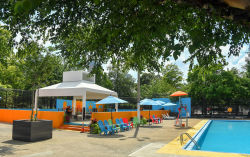Commodore Barry Park
Commodore Barry Park
Commodore Barry Park is located in the Fort Greene neighborhood of Brooklyn. The park was acquired by the Village of Brooklyn in 1836 and for more than a century bore the forthright name “City Park.” It is the oldest park in the borough and was the first to receive a historical sign. In 1951, it was renamed for Commodore John Barry (1745?1803), known as the “Father of the U.S. Navy.” The park is located within walking distance of the former New York Naval Shipyard (Brooklyn Navy Yard), which Barry helped found.
Commodore Barry, sailed to the United States from his native Ireland in 1760. He landed in Pennsylvania, where he found employment in the West Indies shipping trade. Working his way up from cabin boy to captain of the 200-ton Black Prince, Barry gained a reputation as one of the most skilled sailors in the American colonies. When the Revolutionary War began, he was appointed by the new Continental Congress to “fit for Sea the first fleet that ever sailed from Philadelphia.” In April 1776, Barry scored the first naval victory for the Americans, capturing the British sloop, Edward.
Several years later, Barry was briefly re-assigned to escort the Marquis de Lafayette to France on a mission to win financial aid for the Americans. Upon resuming his war patrols after re-crossing the Atlantic, Barry captured nine British vessels in less than a year; funds raised from the sale of these war prizes helped sustain the financially strapped Congress. After the war, Barry was named the first Commander-in-Chief of the United States Navy, serving for 20 years until his death.
The nearby Brooklyn Navy Yard has played an important role in the local economy since opening in 1801, and at its peak in World War II employed over 70,000 men and women before being converted into an industrial park. Commodore Barry Park played a military role of its own during World War I, housing 3,000 sailors and marines in temporary wooden barracks (removed in 1919).
By the 20th century, the park gained fame as a site for African and African American arts. The International African Arts Festival, which began in 1971 as the African Street Carnival, moved here in 2001 to present African Diasporic folk arts, music, and dance. In 2005, the park hosted the AfroPunk Music Festival, inspired by the 2003 documentary Afro-Punk, which examined the contribution of African Americans to the predominantly white punk subculture. The festival has been called the most multicultural festival in the United States.
In 2012, the park’s eastern side underwent a major renovation. The new design added a large, central lawn and performance space and brought features such as benches, trees, and landscaping around the park’s swimming pool to this popular space.
Check out your park's Vital Signs
Clean & Safe
Green & Resilient
Empowered & Engaged Users
Share your feedback or learn more about how this park is part of a
Vital Park System










